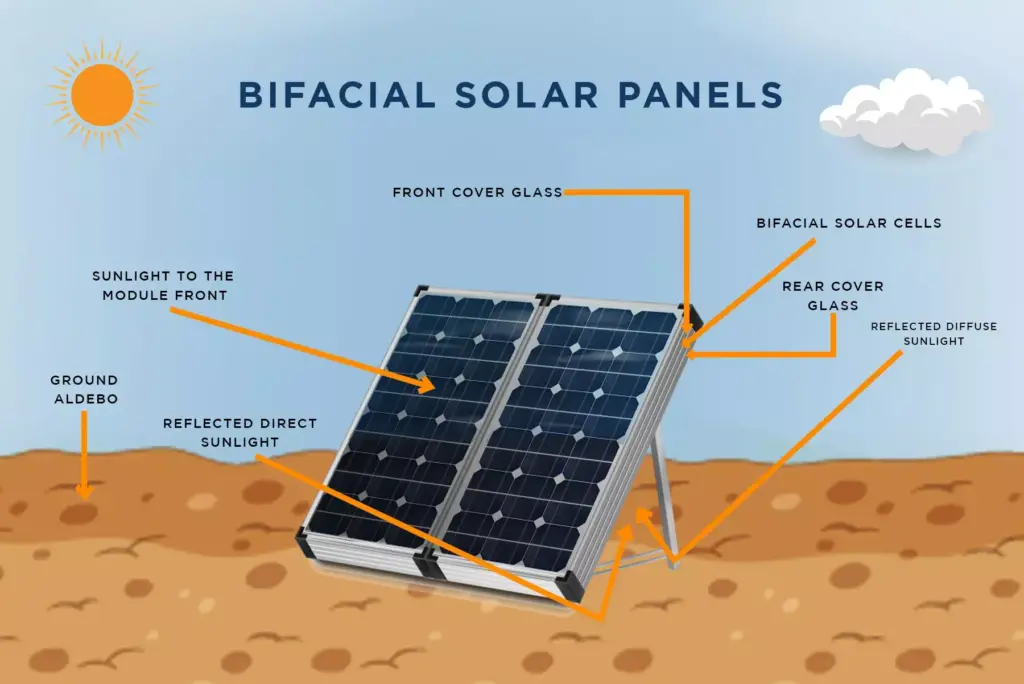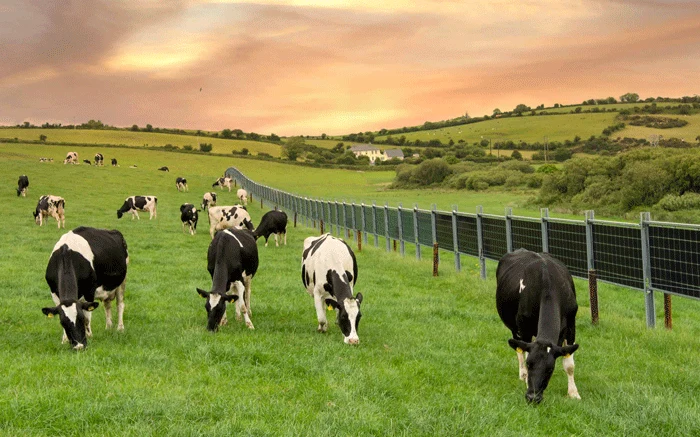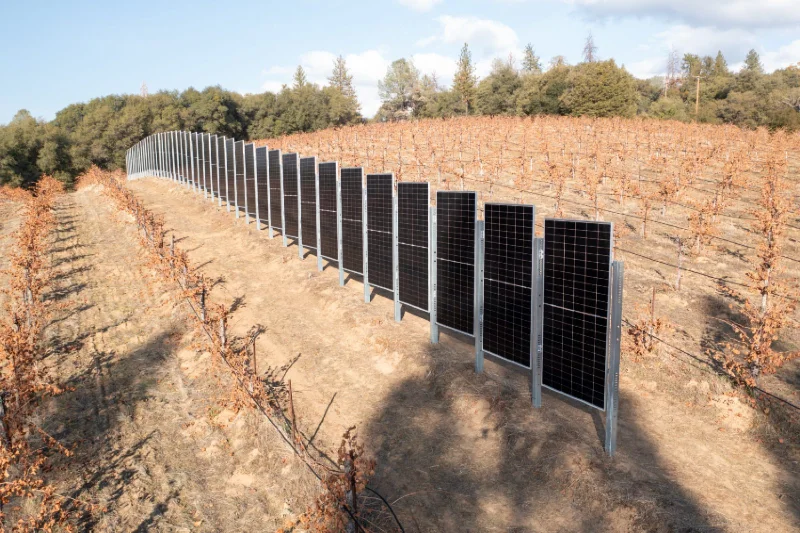Agrivoltaics, the fusion of agriculture and solar power generation, has created a new approach, and viable option, to how we approach sustainable farming and energy production.
As the world shifts towards renewable energy sources, a new player emerges in the US: vertical agrivoltaics. At first glance, it looks like someone just upended a solar panel vertically and while that’s true (and, technically, correct) it’s the method to the madness that could well make a sizeable difference in agriculture.
Vertical agrivoltaics may help redefine sustainable farming and renewable energy at just the time as the world continues to grapple with food scarcity, climate change chaos, and carbon emissions, not to mention the vast amount of greenwashing and its many newly minted cousins that companies have greedily adopted.
What is Vertical Agrivoltaics?
Vertical agrivoltaics is a smart twist in the solar energy playbook, blending agriculture with solar power in a way that respects land use. This approach turns the tables on typical solar farms that hog up vast fields. Instead, it stands out by slotting solar panels vertically, making them more like tall fences in the fields rather than sprawling sun catchers.
In the US, solar developer iSun and German company Next2Sun are spearheading the first vertical agrivoltaics system. Their game plan is unique: they’re using bifacial solar panels mounted vertically. The cool part? These panels work their magic during off-peak hours and avoid monopolizing agricultural land. This method isn’t just theory; it’s already a hit on farms in Germany.

Slated to start construction in 2024 in Vermont, this pioneering system will stretch over 3.7 acres. It’s not just a couple of panels here and there – we’re talking about 69 vertical rack elements, each cradling two bifacial solar modules. And here’s the cherry on top: the space between these solar rows will be home to root veggies like carrots and beetroot, and even some saffron.
Jeffrey Peck, the big boss at iSun, sums it up nicely: “Thanks to the vertical mounting of the modules and the adaptability of the installation to the needs of the farmer, the valuable land is almost completely preserved for agriculture.”
So, how does this all stack up against the typical solar power setups? Let’s dive in and find out.
Top 3 Advantages of Vertical Agrivoltaics
Now, let’s chat about the cool perks of going vertical with solar panels. It’s not just about sticking panels up in a new direction; it’s about getting smart with our space.
Friends with Farms
First off, vertical agrivoltaics is like a best buddy to farmers. It lets them keep most of their land for crops while sneaking in some solar power generation. Imagine solar panels standing tall like guards, letting veggies grow undisturbed underneath. It’s a win-win for farming and energy production.
Sun Chasers
These panels aren’t picky about where they face. Traditional panels need that perfect south-facing spot to soak up the sun. But vertical panels? They’re cool with an east-west setup, thanks to their bifacial design. This means they can catch sunlight coming and going, making them surprisingly efficient.
Everywhere Energy
And here’s the kicker – these panels aren’t just for fields. They can line up along highways, railways, and even on balconies in urban jungles. It’s like turning every spare inch of space into a mini power plant.
In California, there’s already a glimpse of this future. Sunzuan’s vertical system, rocking 43 panels at a winery, is cranking out 23 kilowatts of power. That’s not just a few light bulbs; it’s serious energy.
But hey, no solution is perfect, right? There are some challenges and limitations to consider too.

3 Main Challenges and Limitations
Alright, let’s keep it real for a minute. Vertical agrivoltaics sounds pretty slick, but it’s not all sunshine and high yields. There are a few bumps in the road we need to consider.
- Cost Conundrum: First up, money matters. While vertical panels are easier to install than the traditional elevated ones, they’re still not cheap. Setting up a new technology always has its price tag, and this is no exception. We’re talking about a balance between upfront costs and long-term gains.
- Patience is Key: Then there’s the waiting game. Unlike traditional solar panels that have been around the block, vertical agrivoltaics is relatively new on the scene. This means there’s a bit of trial and error involved. Farmers and investors need to buckle up for a journey that might have a few twists and turns.
- Playing the Long Game: And here’s the big one – results take time. Just like planting a seed and waiting for it to grow, vertical agrivoltaics needs time to show its true potential in terms of energy output and agricultural benefits. It’s not an overnight success story.
Despite these challenges, it’s clear that vertical agrivoltaics has a lot to offer, especially when we weigh the economic and environmental impacts. So, let’s dig into that next.
Talking Dollars & Sense
Now, let’s talk dollars and sense – and by sense, I mean the environmental kind. Vertical agrivoltaics isn’t just a cool concept; it’s got some real clout when it comes to saving bucks and the planet.
- The Cost Comparison: Sure, the initial setup for vertical panels might make your wallet a bit lighter, but think about the long haul. Compared to traditional solar farms that need a ton of space (and money), vertical setups are like the savvy savers of solar energy. They use less land and can be squeezed into existing spaces. Plus, their dual-purpose nature means you’re getting more bang for your buck.
- Earth-Friendly Energy: Environmentally, it’s a breath of fresh air – literally. By pairing up with agriculture, these vertical panels are doing double duty: generating clean energy and supporting sustainable farming. Less land for solar farms means more green space, and we’re all about keeping it green.
- A Sustainable Shift: This isn’t just about today or tomorrow. Vertical agrivoltaics is playing the long game in sustainability. By smartly integrating solar power into our landscapes, we’re paving the way for a more energy-efficient future that doesn’t step on Mother Nature’s toes.
In the grand scheme of things, the investment in vertical agrivoltaics seems like a smart move, not just for the wallet but also for our planet. Up next, let’s take a peek at some real-world examples and see this tech in action.
Agrivoltaics In The Real World

Let’s take a little tour around the world to see vertical agrivoltaics in action. It’s one thing to talk about potential; it’s another to see it turning heads and making a difference.
The Vermont Vanguard
Remember the project in Vermont by iSun and Next2Sun? That’s set to be a trailblazer in the US. With its 69 vertical racks and plans to coexist with crops like carrots and saffron, it’s not just an energy project – it’s an agricultural innovation. Keep an eye on Vermont – it’s about to show us how vertical agrivoltaics can change the game.
California’s Wine Country Wonder
Over on the West Coast, Sunzuan’s vertical system at a Californian winery is already strutting its stuff. With 43 panels generating a sweet 23 kilowatts of power, it’s a shining example of how vertical agrivoltaics can fit snugly into different landscapes – even the picturesque vineyards of California.
Global Glimpses
But this isn’t just a US show. Europe, with its diverse climates and innovative energy strategies, is also hopping on the vertical bandwagon. From Germany’s farm-friendly installations to experiments in harsher climates, the world is waking up to the possibilities of vertical agrivoltaics.
These real-world examples aren’t just proof of concept; they’re beacons of a future where energy and agriculture live in harmony. Speaking of the future, let’s take a speculative leap and imagine what’s next for vertical agrivoltaics.
The Future of Vertical Agrivoltaics
So, where is this vertical agrivoltaics journey headed? Well, as we don’t have a viable crystal ball, the best we can offer you is our educated estimation based on years of experience following green tech, renewable energies, and eco policies. So, with a humble disclaimer, let’s peek into the future.
Beyond the Farm
While today’s focus is on farmlands, the potential of vertical agrivoltaics stretches much further. Imagine solar panels lining highways, perched on urban rooftops, or even integrated into public parks. As cities grow and green space shrinks, vertical panels could be a game changer, offering a splash of green energy in concrete jungles.
Technological Tango
As technology dances forward, expect to see even more efficient and adaptable vertical panels. Innovations could lead to panels that are not only more productive, but also easier to install and maintain. This tech evolution might just make vertical agrivoltaics the go-to choice for new energy projects.
Policy and Partnerships
With climate change on everyone’s mind, governments and companies might start cozying up to vertical agrivoltaics. We could see policies encouraging their use, and collaborations that bring together energy experts, farmers, and urban planners. It’s all about teamwork to make the green dream work.
In essence, vertical agrivoltaics isn’t just a fleeting trend; it’s paving a path towards a more sustainable and energy-efficient tomorrow. As this technology grows and evolves, it could become a key player in our quest for a greener, cleaner planet.
Conclusion
We’ve journeyed through the world of vertical agrivoltaics, exploring its nuts and bolts, weighing its pros and cons, and glimpsing its promising future. Let’s circle back and highlight our key takeaways:
More To Discover
- Panasonic’s Innovative Semi-Transparent Perovskite Solar Panels Look Like Windows or Walls
- New Catalyst Breaks Down Nylon-6 Plastic Pollution Rapidly and Sustainably, Including 46% of Great Pacific Garbage Patch
- Iceland Plans To Drill Into The Heart of a Volcano for Limitless Geothermal Power
- Hermit Crabs’ New Plastic Address: A Sad Sight on Tropical Shores
- Versatility and Efficiency: Vertical agrivoltaics breaks the mold, offering a versatile and efficient way to harvest solar energy without hogging valuable agricultural land.
- Economic and Environmental Harmony: This technology isn’t just about generating power; it’s about doing so sustainably and economically, proving that green energy and green pockets can go hand in hand.
- A Future Full of Potential: With its adaptability and growing interest, vertical agrivoltaics could very well be the next big thing in renewable energy, reshaping how we think about land use and energy production.
If you’re now buzzing with curiosity about sustainable energy solutions and their impact on agriculture, your journey doesn’t have to end here. Consider exploring our other articles on solar energy, renewable energies in agribusiness and our smart farming roundup, or how farmer’s can put AI to use right now.
Vertical agrivoltaics is more than just a smart energy solution; it’s a beacon of hope for a sustainable, energy-efficient future. As we continue to innovate and adapt, who knows what other bright ideas will light the way?





















